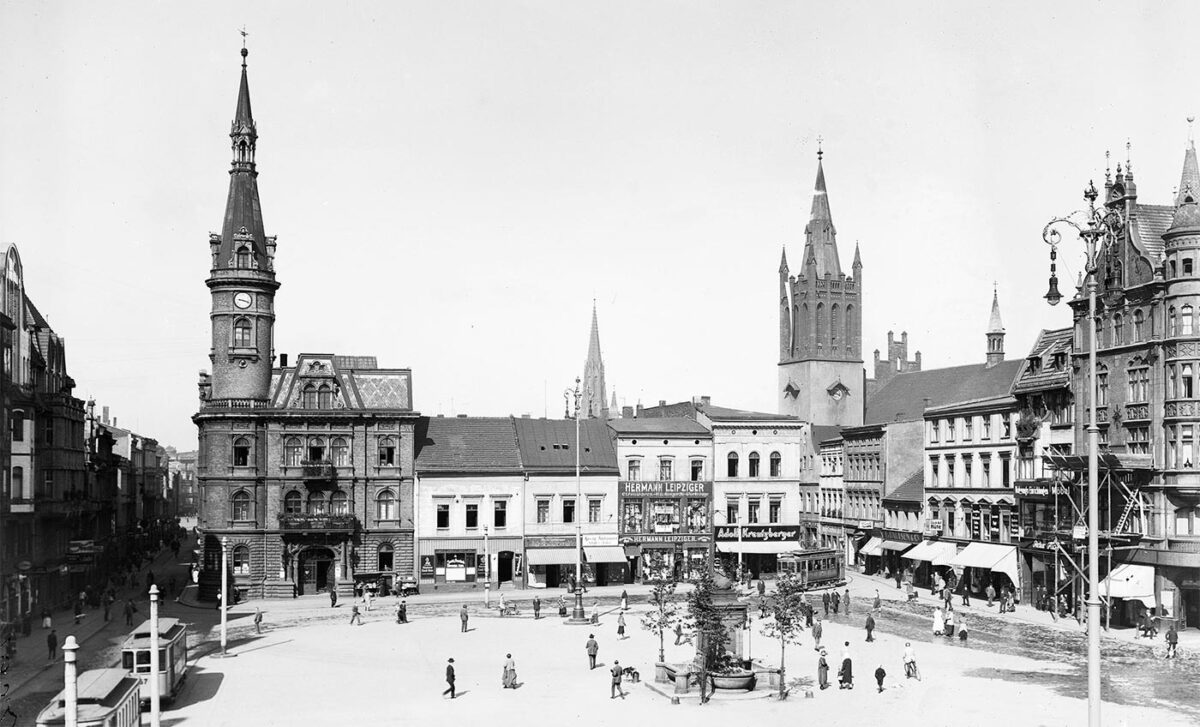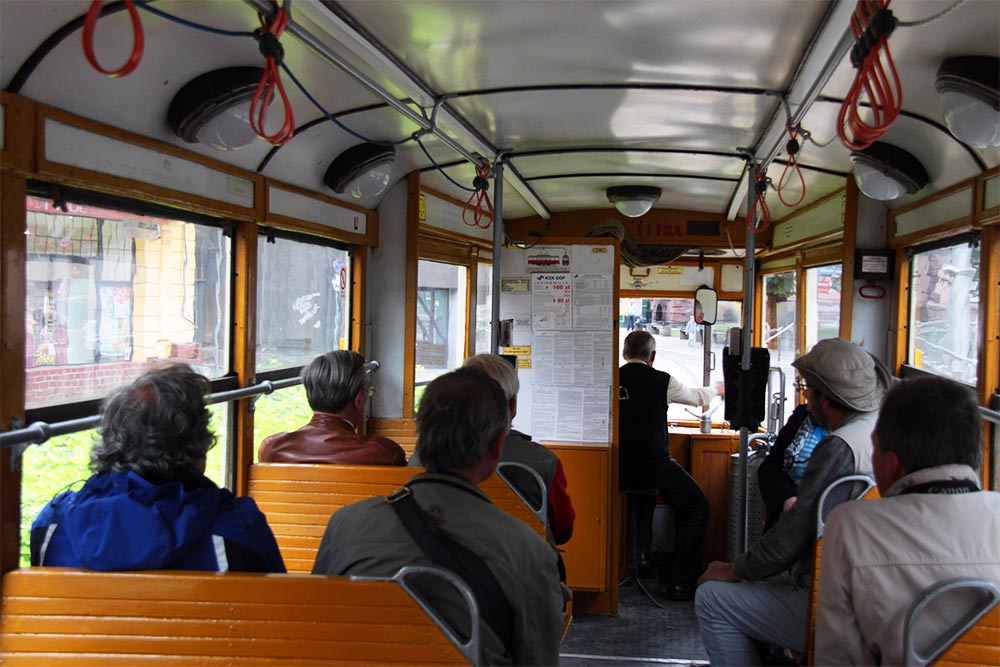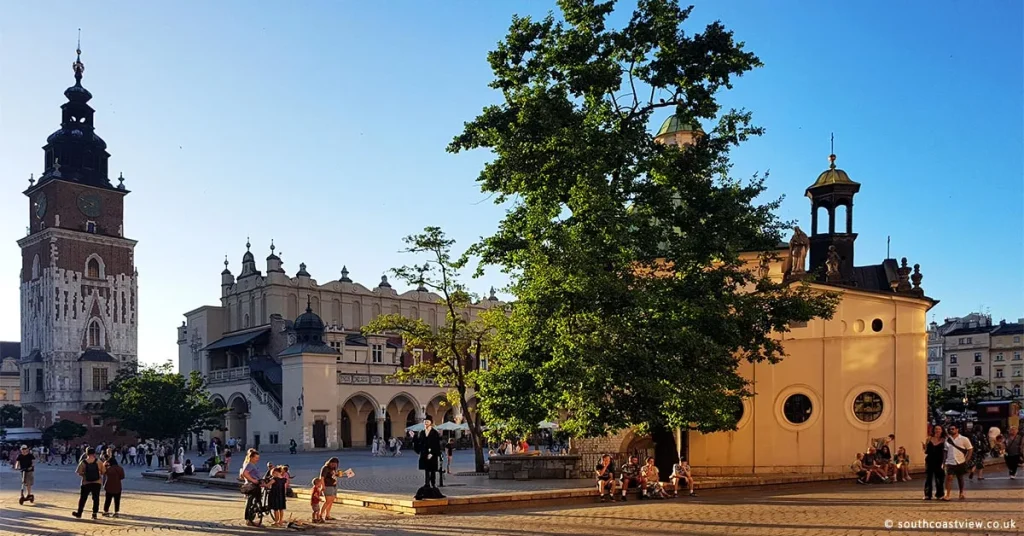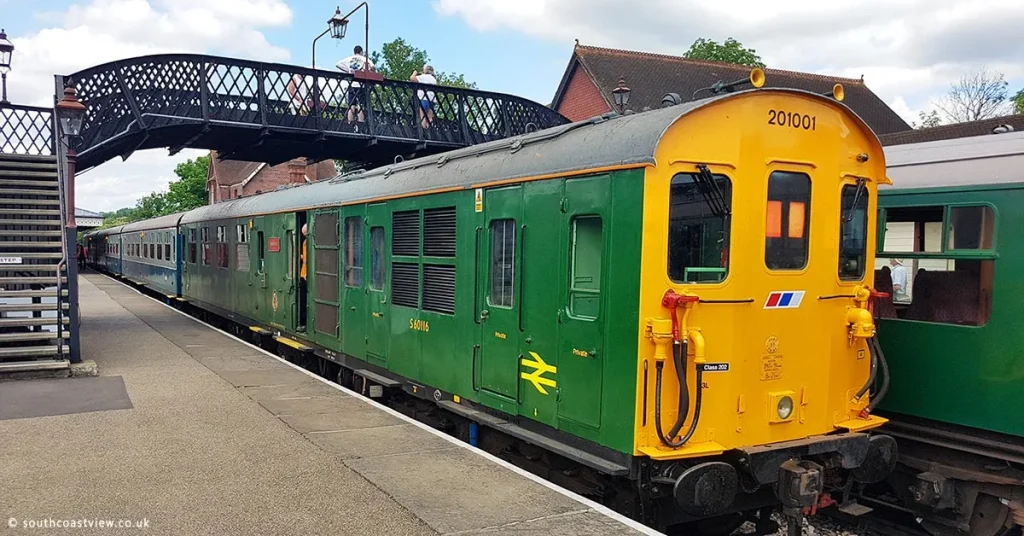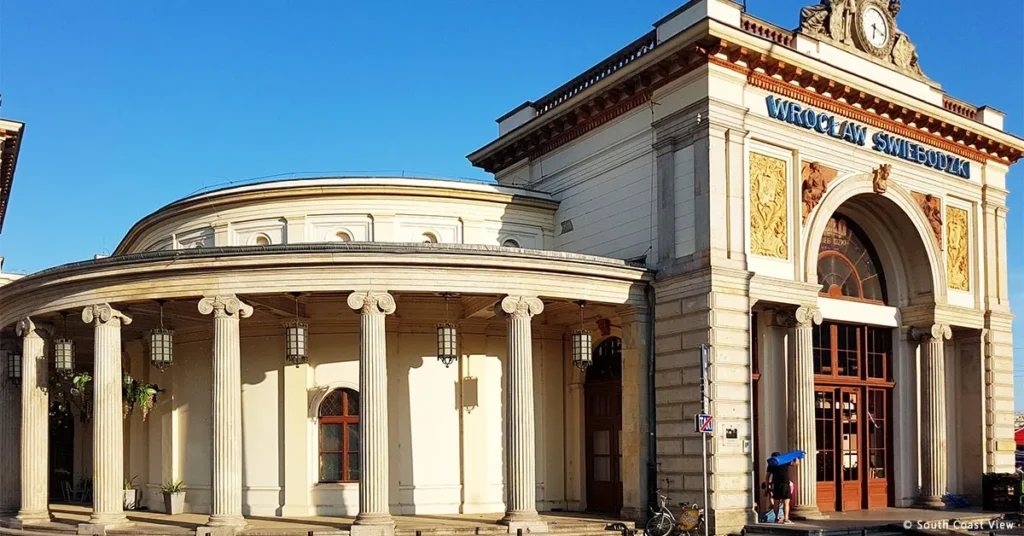Header image above. Derivative work. Original: Adrian Tync CC BY-SA 4.0 via Wikimedia Commons.
Derivative work. Original: aququ, CC BY-SA 4.0 via Wikimedia Commons
Tram Route 38 in Bytom
Tram route 38 in Bytom is part of the Upper Silesian Interurban tramway network in southern Poland.
History of tram route 38 in Bytom
The first trams on Piekarska Street (German Piekarerstrasse) started operating in 1913. Source: Book Tramwaje górnośląskie (Upper Silesian Tramways) published by Eurosprinter, Poland.
The postcard shown here is archived at the Silesian Digital Library, which dates it between 1910 and 1914.
The tram track is clearly visible, and on close inspection, you may be able to see the overhead power line supporting wires attached to the left-hand side of the post office’s first bay windows.
Since the first trams on Piekarska Street commenced operation in 1913, a more accurate date for this postcard could be 1913.
Tram Route 38 in Bytom – A scheduled passenger route
This daily scheduled tram route is one of the iconic visiting points of Bytom. Passengers and tourists can use the route at regular tramway prices.
In March 2020, tram route 38 in Bytom was suspended because the historical Konstal Type N vintage tram cars used on the route could not be adapted to meet COVID-secure health requirements.
The route was reinstated on 9th July 2020 with new Moderus-type low-floor tram cars that meet new health requirements. The Moderus tram cars isolate the driver from passengers, as the driver is separated from the passengers by a cab. The new tram cars are partially disabled-friendly, with a low floor just short of 50% of the tram car length.
A pledge to reinstate the vintage tram cars by the tramway operator and Bytom city authority
Both the tramway operator (Silesian Tramways) and Bytom City authority had pledged to reinstate the vintage tram cars once the pandemic restrictions were eased. The plan was to have the Moderus low-floor trams and the historic Konstal N trams running alternately.
Source: Silesian Tramways press release dated 10.07.2020. In Polish. In Google’s English machine translation.
Updated 29 February 2024: The vintage tram cars were reinstated late in 2023. The vintage trams now run alongside the new low-floor trams on weekends and public holidays.. Source: Miasto Byton (Bytom Cyty) on YouTube. Accessed 29 February 2024. In Polish.
Tram Route 38 in Bytom – Photo Gallery
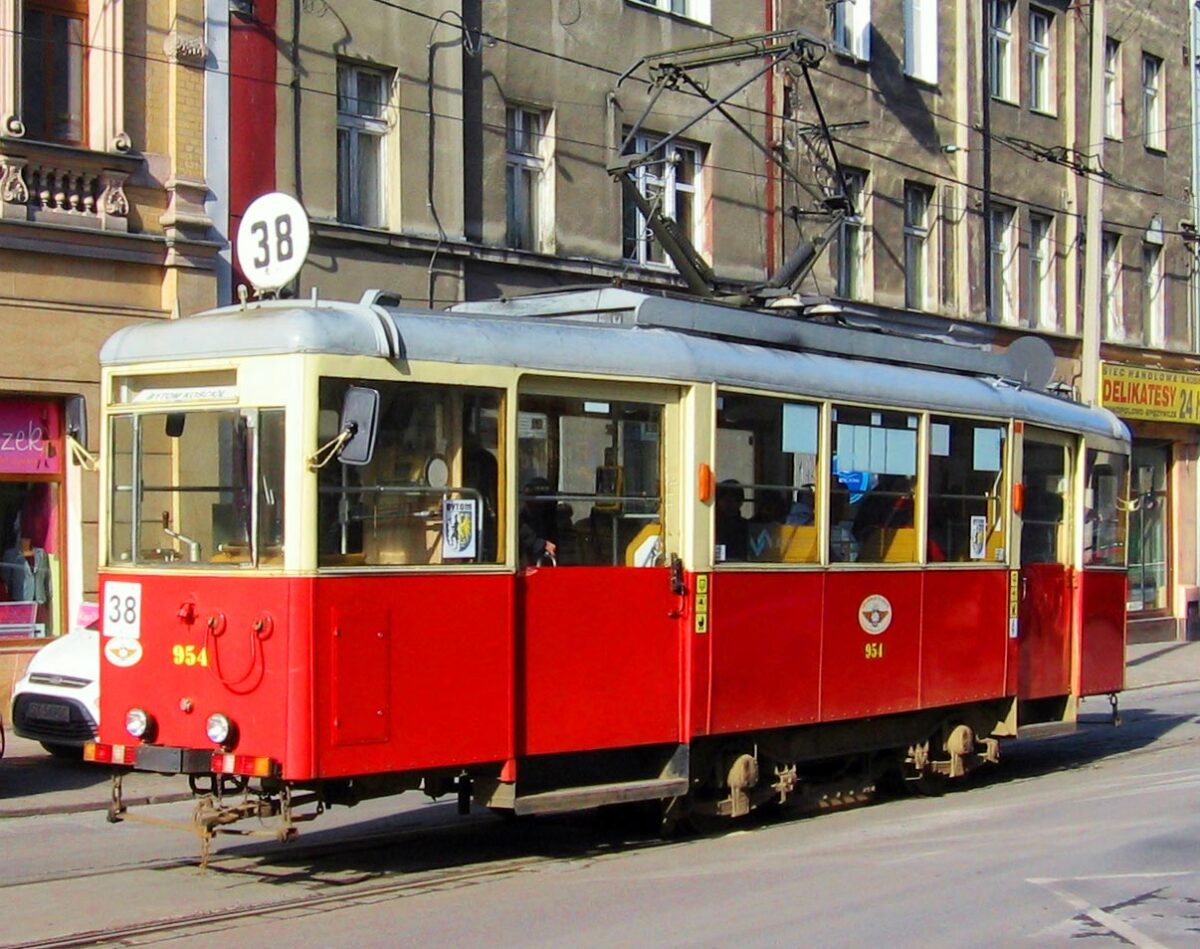
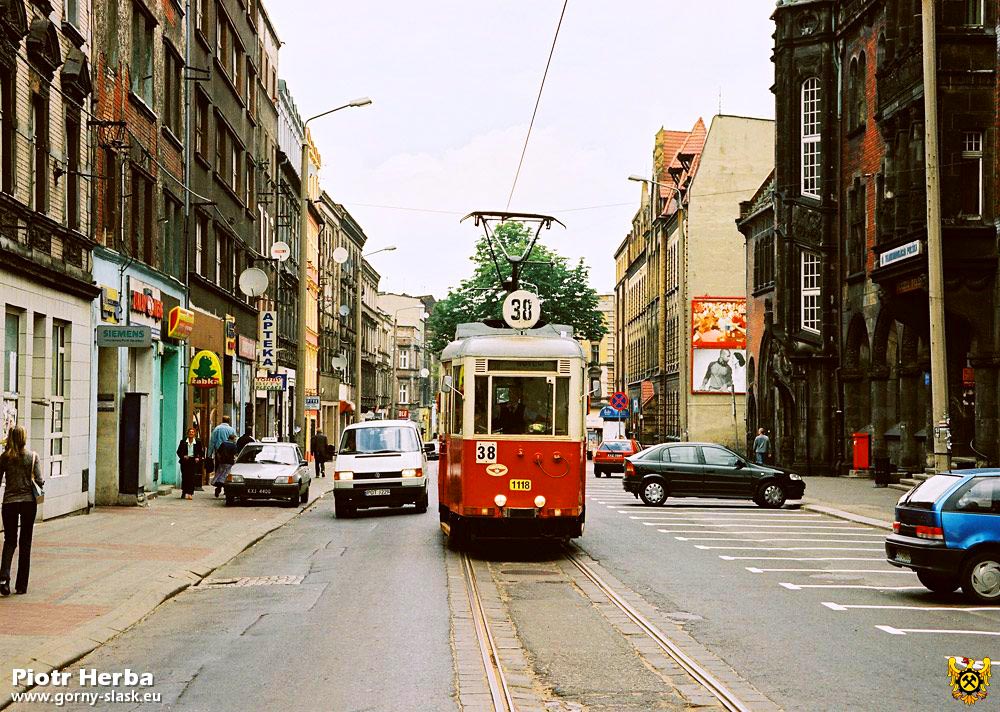
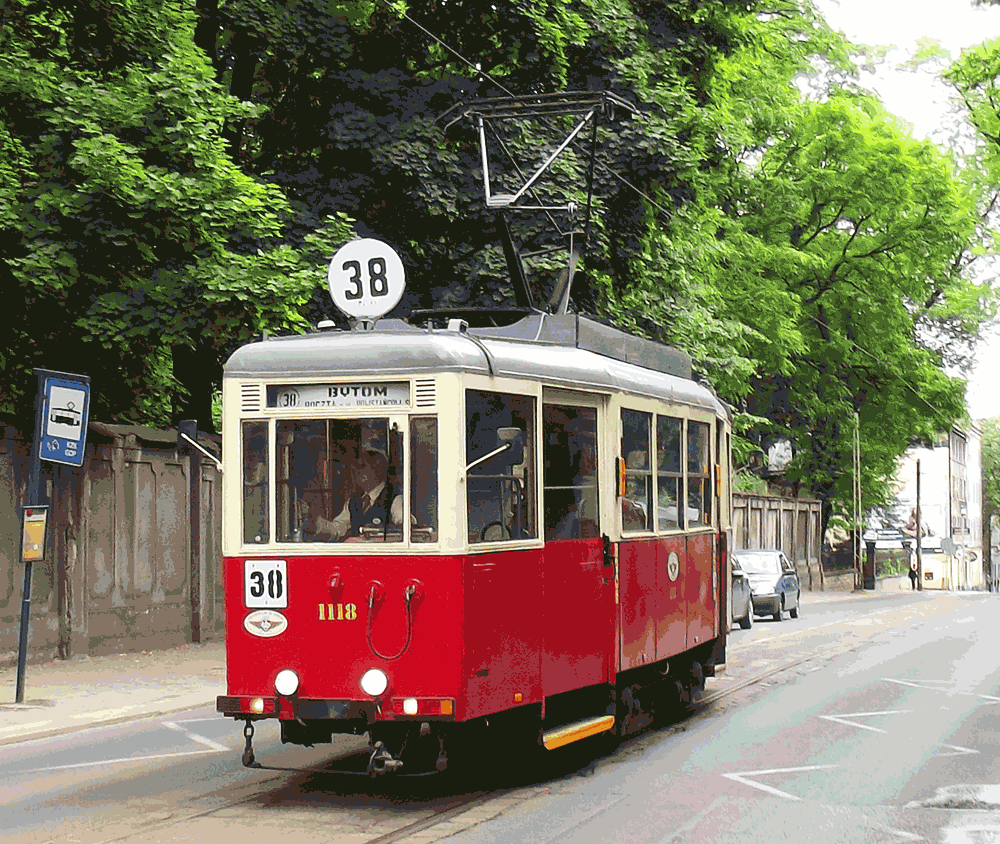






Konstal N trams – Historical details
The Konstal N tram is a bi-directional tram. Therefore, it does not need a loop for turning around. The Piekarska Street tramline is single-track and does not have a loop at either end.
Following World War II, Poland faced an acute shortage of tramway stock. Post-war tramway operators needed a way to produce tramcars as quickly and simply as possible.
The tramway operators decided to construct a modernised version of a German tram car previously manufactured during the war. The German Kriegsstraßenbahnwagen (KSW, short for Kriegsstraßenbahnwagen) began production in Germany in 1943. The KSW was of simple construction yet ideally suited for passenger use during wartime, thanks to its four wide, one-piece, manually operated doors. This meant that during a time of danger, such as an air raid, passengers could be speedily evacuated.
Photo attribution: Bundesarchiv, B 145 Bild-F011897-0005 / Kalesky, Dr. / CC-BY-SA 3.0.
Production of the first Konstal N trams
The first copies of the KSW were produced in 1948, thus beginning the era of the Konstal N-type tramcar and the subsequent development of the Konstal tramcar. The Konstal N 954 type was introduced in 1949, and the Konstal N 1118 type began production in 1951. Bytom has two Konstal N-type tramcars, one from 1949 and the other from 1951. Both models feature in the photo gallery above.
Typically, the tram driver operates these trams while standing. However, at times, drivers like to bring along their office chairs, as illustrated in the photograph. I would do precisely the same.
Konstal N Tram Specifications
| Konstal N Tram | Specifications |
|---|---|
| Car length | 10,400 mm (34 ft 1 in) |
| Width | 2,160 mm (7 ft 1 in) |
| Height | 3,300 mm (10 ft 10 in) |
| Doors | 4 |
| Engine type | LT-31 |
| Traction motors | 2 |
| Power output | 2×60 kW |
| Electric system(s) | 600 V DC |
| Current collection method | Pantograph |
| Wheels driven | 1 |
| Coupling system | Albert |
| Track gauge | 1,435 mm (4 ft 8 1⁄2 in), 1,000 mm (3 ft 3 3⁄8 in) |
| Source: Wikipedia |
Konstal N Tram – How it works
Wrocławska Komunikacja (Wrocław Communications) has a detailed webpage explaining exactly how the Konstal N tram works.
Interestingly, their page indicates that they have previously modified the driver’s cab to include a door to isolate the driver from passengers.
You can find out more in Polish and English using Google Translate.
Watch videos of the Konstal N vintage tram cars working tram route 38 in Bytom
Driver’s view from the Konstal N 1118 vintage tram.
Konstal N 1118 tram working route 38 in Bytom.
Konstal N 1118 tram on the way from the Stroczek tram depot to Piekarska Street in Bytom.
Watch the driver operating the Konstal N 1118 tram.
Images – Attributions
Photo gallery (Tram Route 38 in Bytom)
1. Derivative work. Original: Adrian Tync CC BY-SA 4.0 via Wikimedia Commons
2. Derivative work. Original: Piotr Herba CC-BY-SA 3.0 via fotopolska.eu.
3. Derivative work. Original: Smiley.toerist, CC BY-SA 4.0 via Wikimedia Commons
4. Derivative work. Original: Smiley.toerist, CC BY-SA 4.0 via Wikimedia Commons
5. Derivative work. Original: Nemo5576, CC BY-SA 4.0 via Wikimedia Commons
6. Piotr Brzezina: CC-BY-NC-ND 3.0 via fotopolska.eu
7, 8 and 9: Smiley.toerist, CC BY-SA 4.0 via Wikimedia Commons
If you notice any errors in this article, please get in touch with me. You can write to me in English or Polish.
Please note that words on this page are copyright © South Coast View.
Comments are welcome. Leave a comment below.
Subscribe to future posts by email. No spam, just an email when a new post is published. View the posts.

